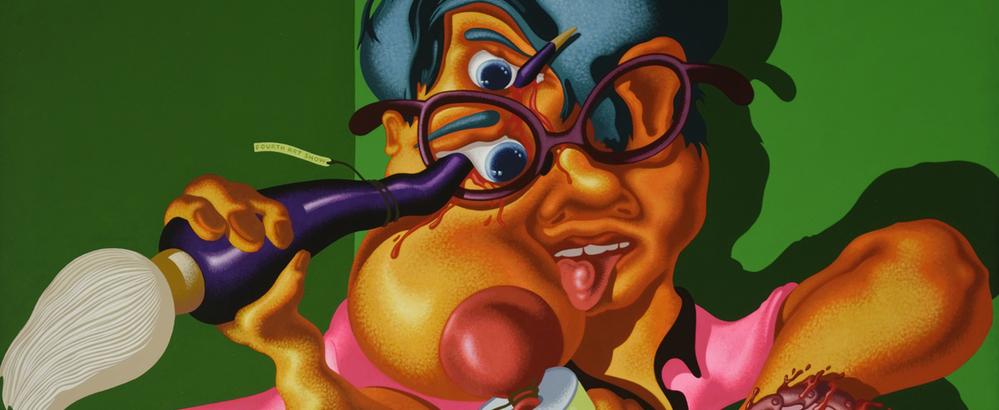
Peter Saul. Oedipus Jr., 1983. (detail) Hall Collection. © Peter Saul
Peter Saul spricht über seine Arbeiten, die in der Ausstellung Peter Saul in der Hall Art Foundation | Reading, Vermont zu sehen sind.

Peter Saul. Oedipus Jr., 1983. (detail) Hall Collection. © Peter Saul
Peter Saul spricht über seine Arbeiten, die in der Ausstellung Peter Saul in der Hall Art Foundation | Reading, Vermont zu sehen sind.
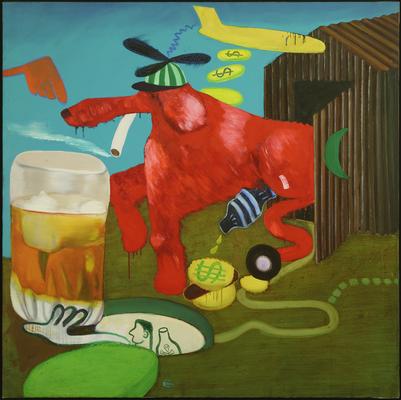
Peter Saul. Rich Dog, 1963. Hall Collection. © Peter Saul
I painted this painting in Rome, Italy. It’s symbolic of life in the United States – that is, everything is a symbol in this picture that I made up as I went along. It was not planned in advance; it was made up as I painted it.
The red dog is a businessman, and that brown house is where he lives. This is pretty obvious. He smokes, and that drink is his reward at the end of the day. But it’s also perhaps poisoned from the little guy under the ground. The hand pointing at his nose is his boss, promoting him, probably. His hat represents the fact that he’s pretty silly and isn’t very intelligent. He’s urinating on some kind of food.
[Klicken Sie unten, um weiter zu hören]
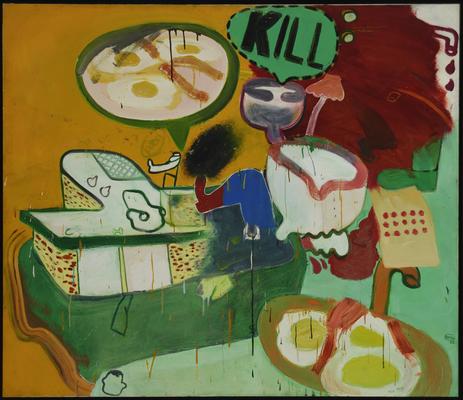
Peter Saul. True Crime, 1962. Hall Collection. © Peter Saul
The way it looks to me now is things out of the American dream sort of thrown into a bathtub with Abstract Expressionist leanings. By 1962, this was not something most art viewers wanted to see, of course. It looks like the figuration was influenced by Dick Tracy comic strips. That house resembles the kind of thing that Dick Tracy might have been involved with. And it is true – I was very interested in those things. As I was growing up, I very much enjoyed Dick Tracy during World War II. All those weird people: Pruneface, Mole Man, Mole Man’s daughter, Moline. Oh, a whole bunch of people. I felt so grateful to Chester Gould that I actually sat down at a café and wrote him a letter.
[Klicken Sie unten, um weiter zu hören]
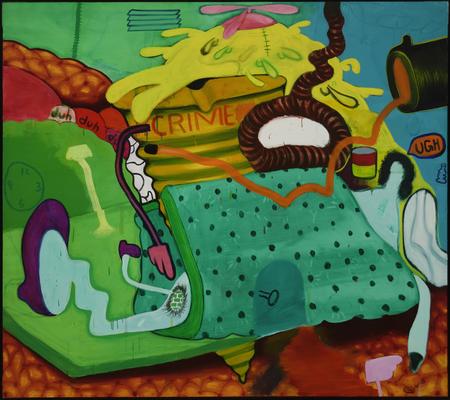
Peter Saul. Sex Crime, 1964. Hall Collection. © Peter Saul
Here’s one from 1964. Again, painted during my last year in Europe, living in Rome, Italy. Sex as humor was not acceptable at this time. However, I couldn’t resist it. That the female corpse should be wrapped up in a blanket is the idea, and the noose is the penalty for this crime. I couldn’t understand why art had so little psychology, why people didn’t use it. Now I realize I was coinciding with the period of time where for reasons I didn’t understand, modern art in America and probably in the world was in a very clean phase. It was involved in design and thinking deeply about those designs and technique, and the way technique works. So I can’t blame it for being clean, but I wanted to make it not that way. I wanted to dirty it up. I wanted to laugh at things that were serious, take art away from serious, responsible concerns, like an obituary would mention, and towards jokes and perhaps foolishness.
[Klicken Sie unten, um weiter zu hören]
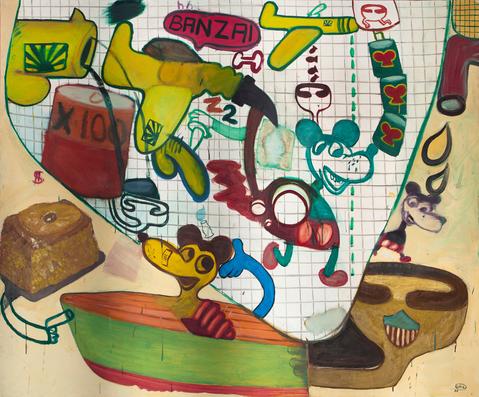
Peter Saul. Mickey Mouse vs. the Japs, 1962. Hall Collection. © Peter Saul
I gave the title "Mickey Mouse vs. the Japs" because it does have a fair amount to do with Japan, as you can see – the color yellow; the word “banzai” is a Japanese symbol. However, I didn’t tie myself down to that subject completely. I would lay anything else in. There’s a can of motor oil that has no purpose having to do with Japan. There’s Del Monte canned goods, which has nothing to do with Japan. There are various toilets running – one is running with little legs, a favorite symbol of mine. And, you know, a motorboat and all that… a piece of food with a menacing kind of a gun. These things occurred to me as a stream of consciousness. Due to the times, any sort of figuration was kind of a rebellion.
[Klicken Sie unten, um weiter zu hören]
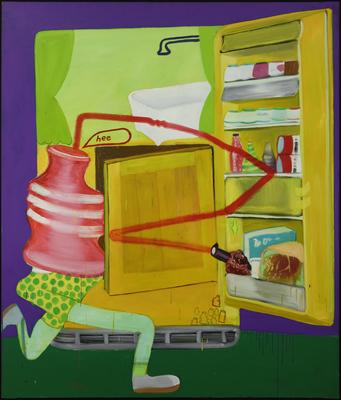
Peter Saul. Ice Box 8, 1963. Hall Collection. © Peter Saul
The ice box was one of my favorite subjects because I just happened to have several in my first art show in New York City in January ’62. For some reason that’s the picture that got the most noticed. So I painted continually several others… altogether maybe ten…. I’m not sure. This is number 8. Again of course, painted in Rome, Italy. It’s a mystery. It’s a mystery I made up as I went along. And I wanted to show motion. Most of the things I did that were figurative that are now what you’re looking at were for some unknown reason not done at that time. My ambition has always been to add something to art, rather than practice what’s already going on.
[Klicken Sie unten, um weiter zu hören]
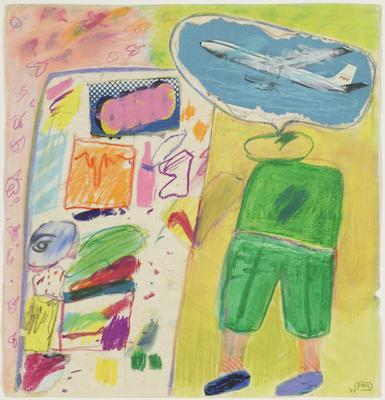
Peter Saul. Untitled (Ice Box), 1959. Hall Collection. © Peter Saul
This little drawing is one of my very first attempts at my art style. I was designing my art style. I was trying to get it going. I didn’t know what I needed for an art style. I hadn’t thought of it previously. I hadn’t painted in an Abstract Expressionist way. I painted a fairly decent copy of Rembrandt’s "Jan Six". I painted a couple of large paintings of cars – American cars, head-on, with no stylistic aim, but just out of interest. And I painted various little things… I’d been painting landscapes.
[Klicken Sie unten, um weiter zu hören]

Peter Saul. Untitled (Lucky Strike), 1960. Hall Collection.
© Peter Saul
This drawing is made with Caran D’Ache crayons, from when I was working in Paris, France – about a year or two before the two paintings you’ve looked at. I’m trying to practice a style of Abstract Expressionism, which as far as I could tell was what was going on in the art world. As I said, I had no knowledge of anything, so I had no idea what was actually going on. But I thought Abstract Expressionism, as exemplified by De Kooning, was probably a good idea. I liked it, and I started doing it in 1958, and continued through ’62, I guess.
[Klicken Sie unten, um weiter zu hören]

Peter Saul. Mad Docter, 1964. Hall Collection. © Peter Saul
This is one of the last paintings I made in Europe before returning to the United States in 1964, and I think I’m getting more conscious of how to paint the subject and skip the art style. And also, of course, I become aware by this time that my work is viewed humorously. So I’m into jokes. I noticed a lack of jokes in modern art – mostly it was very serious. So I felt I was contributing more by putting the jokes in then trying to have a serious attitude, which was already exemplified by a vast number of artists.
[Klicken Sie unten, um weiter zu hören]
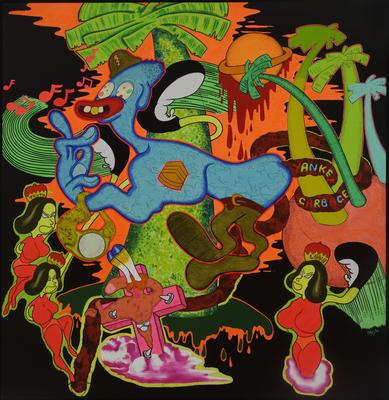
Peter Saul. Yankee Garbage, 1966. Hall Collection. © Peter Saul
This was made back in California. I moved back to the United States and the first thing I noticed was that the subjects I’d been using in Europe, which I’d thought of spontaneously because I could remember them from comic books or whatever, were not sufficient. I needed new subject matter. My picture is driven by subject matter, not by an idea of style. It’s driven by the subject matter – what can I do with it, can it appeal to my imagination, and so on.
[Klicken Sie unten, um weiter zu hören]
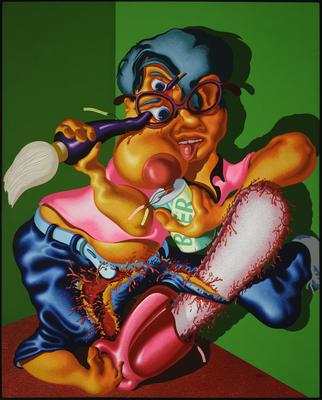
Peter Saul. Oedipus Jr., 1983. Hall Collection.
© Peter Saul
This is a self-portrait, and I think it was motivated by a number of people pointing out to me that my work was extremely aggressive and cruel to other people, and thoughtless and maybe unfeeling towards other people, especially women. And I thought, gee whiz, could this be possible? Let’s get into it. So I made a self-portrait of myself, somewhat distorted, having some of the problems that I’d inflicted on other people in my paintings.
[Klicken Sie unten, um weiter zu hören]
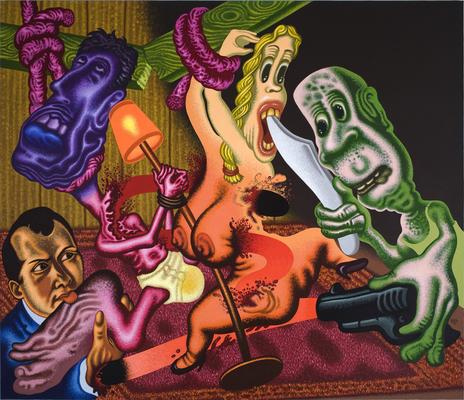
Peter Saul. Beckmann's The Night, 2009. Hall Collection. © Peter Saul
This is a remake of another artist’s picture – Max Beckmann’s painting called "The Night", from shortly after World War I. I decided to redo it and show some of the same anxiety that he showed in his original painting called "The Night", but added to with more special effect like we use today. Today we can’t just hint at things, things have to be absolutely upfront, ‘cause our society permits more graphic doings than their society did. People were more polite previously. Now, less politeness is required. So, I’m redoing his painting.
[Klicken Sie unten, um weiter zu hören]

Peter Saul. Clement Greenberg/Henry Geldzahler, 1971.
Hall Collection. © Peter Saul
Here we have sexual problems carried to the maximum. This idea occurred to me around 1969 as a possibility. People told me I’d treated the war wrong. And of course, for a lot of people where I lived in California, deep truths were coming out as a result of visiting psychologists, and different kinds of gurus were in favor. People were finding out about themselves, and all kinds of stuff. So I thought – supposing you just did this without a feeling of responsibility. I’ve already done the war without a feeling of responsibility, and at least Allan Frumkin thought it was interesting. So here we go with art people.
[Klicken Sie unten, um weiter zu hören]
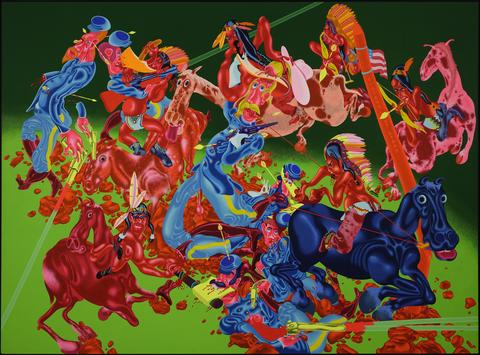
Peter Saul. Custer's Last Stand II, 1974. Hall Collection. © Peter Saul
"Custer’s Last Stand" was the first history painting to actually occur to me, I think in 1969 approximately. I was driving back through Colorado, and I went to the Buffalo Bill Museum. It’s a small museum in Colorado with saddles, Indian headdresses, and a few paintings. One of the paintings was by an artist named Paxson, who did twenty years of research to find out exactly what Custer’s last stand looked like – by interviewing widows, orphans and all that stuff. Anyway I looked at this painting and realized it was incredibly boring. He’s got that whole truth, and it wasn’t worth looking at. So I made a mental note to as soon as I got back (this is in ’69 approximately), to make my version, which would not in any way involve any research, it would be completely opposed to facts and do just what I want.
[Klicken Sie unten, um weiter zu hören]
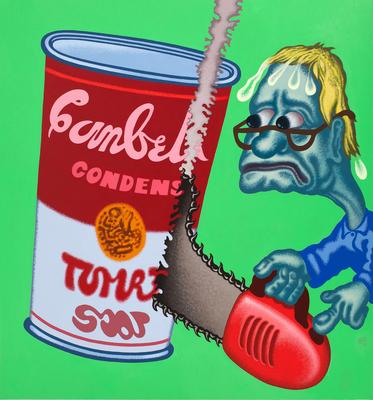
Peter Saul. Peter Saul vs. Pop Art, 2012. Hall Collection. © Peter Saul
That’s me on the right. I felt it wasn’t fair to do Warhol’s can improperly and wreck it in two ways: first I didn’t treat it properly, and then I tore into it with a chainsaw. I felt it wasn’t fair to do that to him and not do something to myself. So I gave myself a sort of a dead look. I decided to take advantage of my age. I’m getting old and I wanted to show this miserable, half-dead quality.
[Klicken Sie unten, um weiter zu hören]
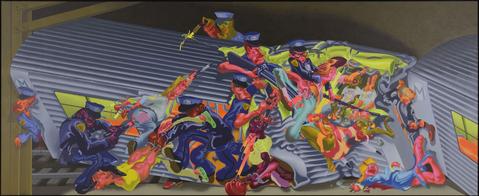
Peter Saul. Subway I, 1979. Hall Collection. © Peter Saul
This is probably one of my largest, if not the largest paintings I’ve painted so far in my life – "Subway" from 1979. I should explain that I use my imagination, of course, to the best of my ability. I simply wanted to imagine what it would be like if in one subway incident, everything happened on one subway car. You’d have massive murder, retribution, theft, rape… everything. The whole works of crime would be happening right there, and the police would be taking charge.
[Klicken Sie unten, um weiter zu hören]
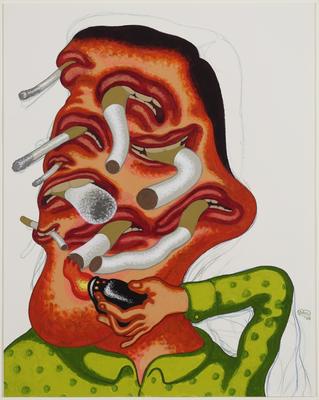
Peter Saul. Smoking Head, 2008. Hall Collection.
© Peter Saul
This simple drawing from 2008 reveals that I was a heavy smoker until I quit 31 years ago. I enjoyed smoking a great deal. Smoking helped me get over all the problems of my life. This insults smoking unfairly. I don’t mind second-hand smoke, even today. I’m not mad at people who smoke. I happened to quit because it made me nervous. I feared lung cancer. This is 31 years ago.
[Klicken Sie unten, um weiter zu hören]
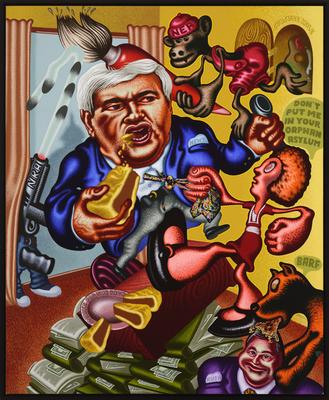
Peter Saul. Newt Gingrich vs. Orphan Annie, 1995.
Hall Collection. © Peter Saul
These are political symbols all jumbled up. I made it up as I went along, pretty much…half and half. For instance, there’s the NEA and NRA, National Rifle Association, over on the left shooting a lot of bullets; a little gun with legs trying to blast that paint brush from the NEA which I guess is an arts organization, which comes out of the culture hole, it looks like. Yeah well, you know, why not. I like making these kinds of paintings because you have to think fast. There you are in the middle of a painting, you’ve got space, is there anything you can put there that might be interesting and significant for the painting? See, I want to be interesting.
[Klicken Sie unten, um weiter zu hören]
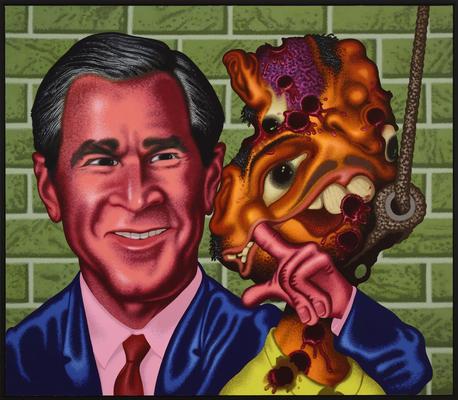
Peter Saul. Bush At Abu Ghraib, 2006. Hall Collection. © Peter Saul
Here we have attempt at propaganda. I hope it worked. I never know. Usually I think propaganda is a good idea if it goes too far. If it doesn’t, if it stays within bounds, I think it’s lousy. So let’s hope I went too far with this picture. Here’s President Bush paying a surprise visit to the prison in Iraq where some GIs made a big mistake and didn’t treat people right. It happens in every war, probably. But in this case, the Iraqi is not good to start with… both ears are on one side of the head. He’s all messed up to start with and then he’s been shot further, and looks like hit. And he’s got a noose around his neck. President Bush is proud of this. He’s sort of pointing it out like a hunter would at a deer carcass. So this is pretty heavy propaganda.
[Klicken Sie unten, um weiter zu hören]
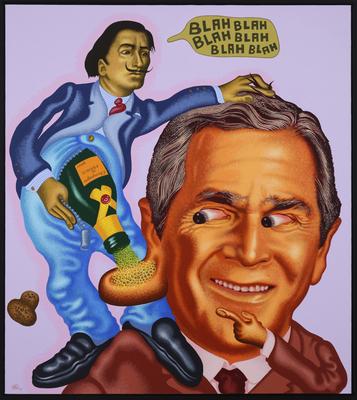
Peter Saul. Dali Advises the President, 2004. Hall Collection.
© Peter Saul
Salvador Dali is giving some good advice to President Bush, with symbolism of a Champagne bottle poofing out Champagne, which does look a lot like urination. Let’s face it, when you drink Champagne it’s got those little bubbles on top. And he’s talking in a sensible way, saying “Blah blah blah blah.” [...] There we have George Bush, worried about this advice, I think. He’s not sure it’s really significant. On the other hand those little eyeballs seem thrilled. It’s just the question of getting some psychology into the picture that permits it to be interesting.
[Klicken Sie unten, um weiter zu hören]
